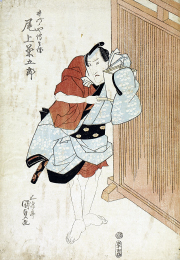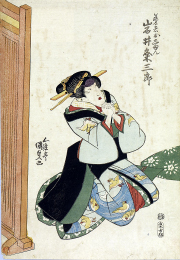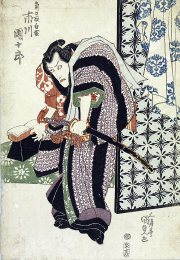| MIGAWARI OSHUN |
| Play titles | Migawari Oshun Sono Uwasa Sakura no Irodoki Okuni-iri Soga Nakamura Edo no Hana Mimasu Soga |
||||||||||||||||||||
| Common titles | Migawari Oshun Oshun Denbę |
||||||||||||||||||||
| Authors | Sakurada Jisuke I (lyrics) Tomimoto Buzendayû II (1783 music) Kiyomoto Enjusai (1825 music) |
||||||||||||||||||||
| History |
Sakurada Jisuke I's dance-drama "Migawari Oshun" was premiered in the 3rd lunar month of 1783, in Edo at the Nakamuraza. It was a Tomimoto-based dance-drama which ended the nibanme program of the new year sogamono drama "Edo no Hana Mimasu Soga". It was revived 42 years later, in the 1st lunar month of 1825, in Edo at the Nakamuraza. It was entitled "Sono Uwasa Sakura no Irodoki" and it was staged with a Kiyomoto ensemble to end the nibanme program of the new year sogamono drama "Okuni-iri Soga Nakamura". The title "Migawari Oshun" was used for the first time in April 1905 at the Miyatoza. The dance-drama "Migawari Oshun" is rarely-staged on Kabuki stages; since the end of World War II and up to the end of the 20th century, we've found only 3 records of performances in ôshibai between 1948 and 1998:
|
||||||||||||||||||||
| Key words |
Akushichibyôe Kagekiyo Genji Hanakawado Heike Kagekiyomono Kiyomoto Migawari Migawarimono Minamoto Noriyori Minamoto Yoritomo Okiya Oshun-denbęmono Sumôtori Taira Kagekiyo Tenugui Todana Tomimoto Yu-gaeri |
||||||||||||||||||||
| Summary |
At the okiya in Hanakawado of the courtesan Oshun, a group of young people are happily rehearsing for today shrine festival, although Oshun herself is away from home at the moment, having gone out to the local bathhouse. Into this merry group of people suddenly comes an unwelcome and uncouth guest. It is a Genji warrior named Umino Heiji [1], who tempts them with an offer of reward for the capture of a princess named Sonô-no-Mae. She is heavily desired by Minamoto no Noriyori, the brother of the Shôgun Minamoto no Yoritomo. But Sonô-no-Mae has spurned him, because she was betrothed to Tsunewakamaru, a youthful scion of the defeated Heike clan. Her life is clearly in danger. It happens that the courtesan Oshun is in reality Hitomaru, daughter of Taira no Kagekiyo, a leading general of the defeated Heike clan. She has in the past served Sonô-no-Mae, and is now also anxiously trying to locate her former mistress in order to be able to serve her again, and help her turning her marriage with Tsunewakamaru to reality. Ironically, Oshun's own lover Izutsuya Denbę [2] serves the victorious Genji clan, and is under direct orders from the jealous Minamoto no Noriyori to find and kill Sonô-no-Mae. However, Denbę is unaware of Oshun's true identity and her loyalty to Sonô-no-Mae's cause. Oshun, realizing their opposing stands, picked a quarrel with Denbę the night before in an attempt to make a break, although she still loves him. Now, as she returns from her bath (yu-gaeri), she appears worried about what his present feelings towards her might be. Meanwhile, Denbę himself, his face masked under a tenugui, comes furtively to the house. He is still in doubt as to Oshun's true feelings and has come to try to sound her out once more. However, he is hurt by her apparent change of heart, and has come prepared to kill her if he should find her truly unfaithful. Denbę asks Oshun whether she has really meant all the unkind things she said the night before. Oshun answers by saying that she has heard from their mutual friend Shirafuji Genta, a sumôtori, that Denbę is in reality a samurai and that he is engaged in a search for Sonô-no-Mae to take her life. Denbę takes her words to be an accusation of keeping a part of his life secret from her, and apologizes for having done so. Oshun suddenly asks Denbę to leave. Denbę is angry and disappointed, and suspects that maybe Oshun is deserting him in favor of Umino Heiji. Oshun confirms his suspicions in her answer. Denbę angrily tries to draw his sword, but Oshun asks him to wait a moment. She says that first she wants to tear into pieces before his eyes a certain silken garment she had received from him, as a sign that she no longer loves him. But when she opens the closet (todana) she is confronted by the figure of the princess Sonô-no-Mae, hiding inside the closet! Quickly she shuts the door again, and then asks Denbę instead to write a letter of separation. But she words her request in an ambiguous way that makes it sound as if she were requesting her lover to literally cut her (kill her with a sword) rather than sever their relations. Denbę, having seen the figure in the closet, quickly realizes the situation. But he goes along with Oshun's pretense. He writes and hands her the letter of separation. Then he takes his leave, sorrowfully saying his farewell to her in his heart, because he knows now he will never see her alive again. After he is gone, Oshun opens the closet again, and Sonô-no-Mae comes out. Oshun promises that she will keep the princess in hiding, and do all she can to help her unite again with Tsunewakamaru. But someone approaches, so Sonô-no-Mae hides again in the closet. The sumôtori Shirafuji Genta enters the room. He confides to Oshun that he was the one who has hidden the princess in the closet and Oshun expresses her gratitude. Then, in order to make it appear that she has indeed been unfaithful to Denbę, so as to lead him into killing her, Oshun starts to seduce Genta, confessing that she loves him. She says that she has separated from Denbę, and shows him Denbę's letter as a proof. Genta, who is more aware of the situation than she guesses, suddenly says that he will grant her wish... not to become her lover, but to cut her with his sword. A sudden wind blows out the lamp as Genta kills her. Denbę comes hurrying to the scene. Genta, who has meanwhile beheaded Oshun, places her head in a flower basket and presents it to Denbę, saying that it is the head of Sonô-no-Mae. Both men are aware of Oshun's ultimate sacrifice. Denbę grievingly accepts the head as Sonô-no-Mae's head and he will bring it to Minamoto no Noriyori. Umino Heiji suddenly appears and tells them that he has perfectly understood their plot to deceive Noriyori. Without any hesitation, Denbę kills him to preserve the secret of the substitution (migawari), and then takes up Oshun's head sorrowfully in preparation for his departure. |
||||||||||||||||||||
| Notes |
[1] The warrior was Banba no Chûta in January 1959 at the Kabukiza. [2] Izutsuya Denbę or Izutsu Denbę. In 1783, he was named Kamakuraya Denbę. |
 |
 |
 |
|
The actors Onoe Kikugorô III, Iwai Kumesaburô II and Ichikawa Danjûrô VII playing the roles of Izutsuya Denbę, Oshun and the sumôtori Shirafuji Genta in the drama "Sono Uwasa Sakura no Irodoki", which was staged in the 3rd lunar month of 1825 at the Nakamuraza (print made by Utagawa Kunisada I) |
||
|
|
| Contact | Main | Top | Updates | Actors | Plays | Playwrights | Programs | Links | FAQ | Glossary | Chronology | Illustrations | Prints | Characters | Derivatives | Theaters | Coming soon | News |